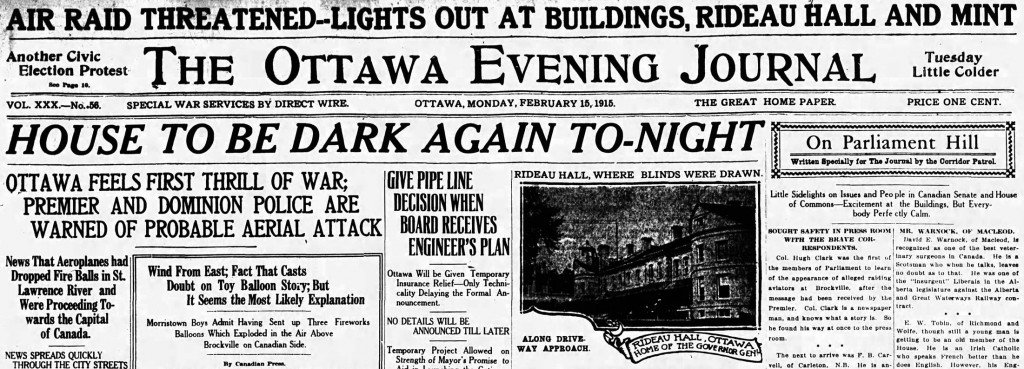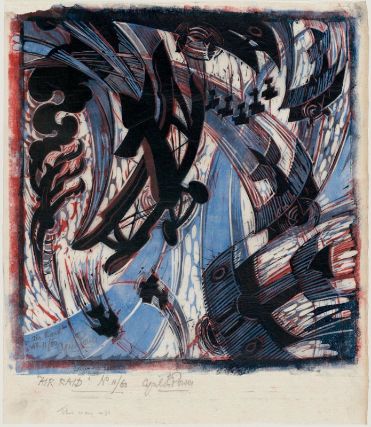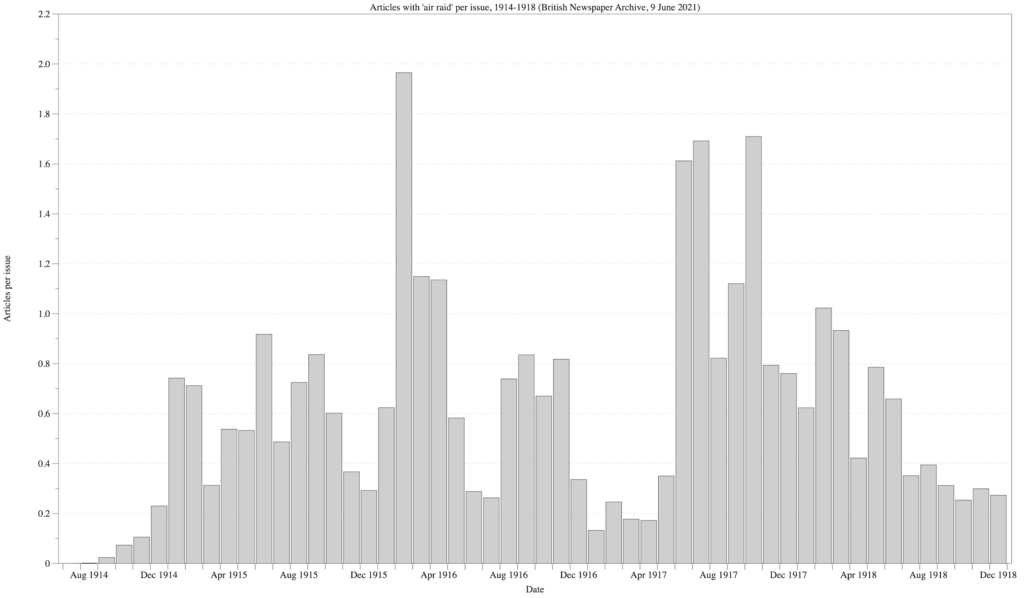[Cross-posted at Society for Military History Blog.]
On 15 February 1915, the Winnipeg Evening Tribune's daily astrology column noted the unfavourable positions of Mars and Uranus:
The affliction of Mars this month is ominous of outrages against persons in power. A disaster that will shock the people living in cities is threatened.
Uranus foreshadows peril from aeroplanes or Zeppelins. National alarm from unexpected causes is presaged by the planets.1
Readers might indeed have been excused for being alarmed, for the previous evening, Ottawa, the Canadian capital, had been placed on high alert due to reports of aircraft approaching it from the United States border. While no attack actually eventuated, the omens were not good -- at least according to the McClure Newspaper Syndicate's anonymous astrologer.
The morning after, the Prime Minister, Sir Robert Borden, informed the House of Commons that
about nine o'clock last evening [14 February 1915] the mayor of Brockville telephoned to me that three aeroplanes had crossed over Brockville, going to the north, and that one of them had turned a searchlight upon the town, lighting up very considerably the principal street. On receiving the information I communicated it to the chief of the general staff, with the suggestion that it should also be made known to the Commissioner of Dominion Police.
Brockville, named after the Hero of Upper Canada, is about 60 miles south of Ottawa and lies across the Saint Lawrence River from Morristown, New York. Hence, it appeared that the three (or four) aeroplanes were flying from the United States towards the Canadian capital. 'Three constables and a number of civilians' saw them, having had their attention attracted by 'The noise of the motors'.2 One of the aeroplanes was even reported to have 'dropped several fire balls or light bombs' into the river as it crossed.3 Given this evidence of a possible air raid in progress, the Commissioner of Dominion Police, Colonel Percy Sherwood, prudently ordered 'that all lights on Parliament Hill should be extinguished so that in the event of an aerial attack on the city, the brilliantly lighted buildings would not be a mark for the invaders'.4 The Royal Mint and at Rideau Hall, the Governor General's residence, were also darkened. The Dominion Police as well as the major towns of eastern Ontario were warned 'to keep a sharp look-out' and 'report any appearance of aeroplanes'.4 Despite the inclement weather, Ottawans gathered in the streets to look out for the raiders.5
But the aeroplanes never reappeared. The night was dark and wet, and there was a headwind; still, it was estimated that they should have been able to reach Ottawa, if that was their destination, by midnight. It was 'The air raid that didn't'.4 The following morning, news arrived from Brockville suggesting that the aeroplanes were merely 'paper fire balloons', which had been 'sent up last night ostensibly to commemorate century [sic] of peace'.4
That might seen to be have been an end of the matter. However, the fire balloon explanation was discounted 'In official circles', and Parliament remained dark the following night.6 Border guards were ordered 'to keep a sharp look-out for any air craft [sic] which may appear and at once fire upon them'.4 Investigations were set in train:
The militia authorities have been in communication with Washington regarding the aeroplane raid of Sunday evening, and the most thorough inquiry has been set on foot to discover, if possible, the base from which the aeroplanes started for Canada.4
It wasn't Americans, as such, who were feared, however, but German-Americans:
It is known in Ottawa that there are German societies and sympathizers in the United States who have contemplated action of some kind against Canada. Early in the war Germans at various centres in the United States were drilling under arms with the object in view of making a descent upon Canada to destroy canals and railways, or perhaps even take part in the war on a more extended scale. Representations were made by the Canadians Government to Washington and the organization was stopped.3
As the Ottawa Evening Journal noted, there existed something of a precedent for this, in the form of the Fenian raids of the 1860s. Even then, there were false alarms, as when two 'little grain sloops [...] set Owen Sound in a tremble and the cry was heard along the streets:-- "The Fenians are coming!"'4
Ottawa's phantom air raid was not the only time that mystery aircraft were seen over Canada during the First World War. I initially planned to write this post as a simple chronological summary, but apart from that approach being dull, there were just too many. Instead I've plotted the numbers of mystery aircraft incidents above, from the two aeroplanes seen by residents of Sweaburg, Ontario, on 12 August 1914 to the strange lights, reminiscent of an aeroplane, seen by a telegraph operator at Newport Point, Quebec, in late December 1917. It's an undercount and skews towards earlier dates: in some cases the information is quite vague, so if there's a report of aeroplanes being seen over a period of several months then I count it only once and at the start of the period.
My sources here are, unfortunately, almost entirely secondary. The open access Canadian newspaper archives available online contrast poorly with their Australian, New Zealand and even British counterparts: the number of titles is reasonable, but they are fragmented across many different sites and the search capabilities are generally badly designed and implemented. So, apart from the Zeppelins of Halifax, I've relied upon two secondary sources, both quite thorough and with a fairly low degree of overlap: Robert Bartholomew's article in Canadian Military History, which is available in open access, and the chapter written by Mr. X in the edited volume The Scareship Mystery, which was published by a small press 14 years ago and will unfortunately be hard to find.7 Both cite newspapers extensively, but Mr. X also draws on eyewitness statements and intelligence reports in the Canadian Federal Archives.8
So, what was going on? From the plot above, it's clear that most mystery aeroplane sightings were in the first year of the war, declining to a steady trickle in the second year, and practically none after that, apart from a small scare at the start of 1917. This quite a different pattern to Australia and New Zealand, which had their biggest scares in 1918. Certainly, as both Bartholomew and Mr. X note, the presence of the United States, long a source of danger to Canada, must have played an important role. It harboured a large population of German-Americans, contained far more aeroplanes than did Canada and was initially neutral. Certainly, there were very few reports after the United States entered the war in April 1917; Canadians presumably felt safer after that.
But that doesn't explain the specific peaks, around September-October 1914 and July 1915. The first of these is easy enough to understand, since the war had just started, Canada was mobilising, and nobody knew just how far Germany's reach extended. There was a similar early war phantom airship scare in Britain; Australia had a small-scale mystery aeroplane scare around October, apparently associated with the first convoys of troops overseas. There isn't an obvious explanation for the July 1915 scare in Canada, which took place mostly in southwestern Ontario, again close to or on the American border, as well as in Quebec. Mr. X suggests that the expansion of aircraft factories and training aerodromes from May might have had something to do with it; there were apparently suspicions within the Department of Militia and Defence that the enthusiasm of the Montreal Flying School for conducting searches for secret German bases in the Laurentian Mountains had something to do with the new aeroplane it requested in order to carry them out!9 More finely-grained research might turn up more specific threats to serve as triggers: such as a fire at an explosives factory at Rigaud, Quebec, 'now connected with the visits of the aeroplanes to that district, or rumours of a battle between a British warship and a German submarine off Halifax.10
For now, it's clear enough that Canadians were concerned about the possibility of a repeat of the Fenian raids but by Germans and from the air. (On the ground, there certainly were some acts of sabotage by German agents, though only a handful.) They may have been comforted had they realised that one of the false alarms during the Fenian scares was a January 1865 report by a frontier guard at Amherstburg of 'a bright light [which] appeared at an angle of fifteen degrees above the horizon', which remained 'stationary about five minutes and descended in fifteen'; telescopic observations revealed a 'lantern attached to a kite'.11 The local militia commander, W. Osbourne Smith, believed this to be a Fenian signal; the commander of the Western Frontier Constabulary, Gilbert McMicken, came down to have a look and concluded that it was just a star.
Image source: Ottawa Evening Journal, 15 February 1915, 1.
![]() This work is licensed under a Creative Commons Attribution-NonCommercial-NoDerivatives 4.0 International License.
Permissions beyond the scope of this license may be available at http://airminded.org/copyright/.
This work is licensed under a Creative Commons Attribution-NonCommercial-NoDerivatives 4.0 International License.
Permissions beyond the scope of this license may be available at http://airminded.org/copyright/.
- Winnipeg Evening Tribune, 15 February 1915, 6. [↩]
- Ottawa Evening Journal, 16 February 1915, 12. Witnesses totalled 'half a dozen': Winnipeg Evening Tribune, 15 February 1915, 1. [↩]
- Ottawa Evening Journal, 15 February 1915, 1. [↩] [↩]
- Ibid. [↩] [↩] [↩] [↩] [↩] [↩] [↩]
- 'There was a good deal of excitement. Excitement in Ottawa does not as a rule manifest itself by noise. The first sign that there is something unusual is that utter strangers stop in the streets and converse freely. Each seeking any news the other may be able to dispense.' Ibid. [↩]
- Ottawa Evening Journal, 16 February 1915, 12. [↩]
- Robert E. Bartholomew, 'Phantom German air raids on Canada: war hysteria in Quebec and Ontario during the First World War', Canadian Military History 7, 29-36; Nigel Watson, ed., The Scareship Mystery: A Survey of Worldwide Phantom Airship Scares (1909-1918) (Corby: Domra, 2000), 111-28. [↩]
- The files he cites are MIKAN numbers 1893486, 1893487, 1893502, 1893514, 1893515 (the most important file), and 1896430. [↩]
- Watson, ed., The Scareship Mystery, 121. [↩]
- Ottawa Evening Journal, 20 July 1915, 2. [↩]
- No. 4 Frontier Police (William Black), quoted in Watson, ed., The Scareship Mystery, 112. [↩]







Pingback:
The air raid that didn’t | Society for Military History Blog